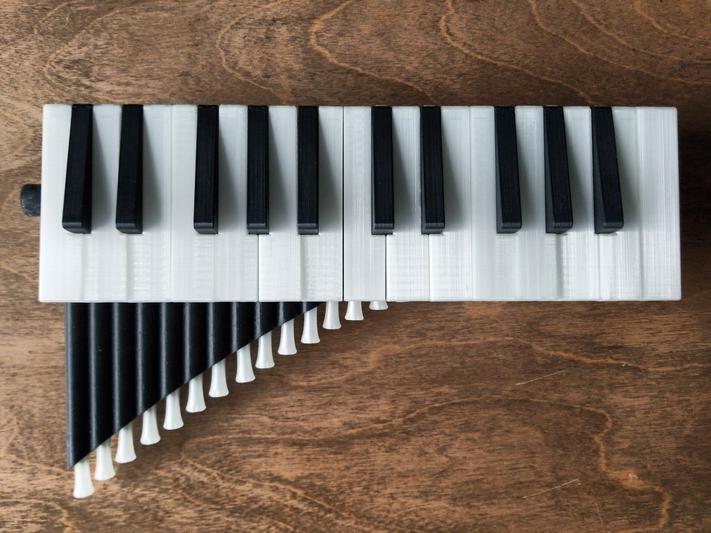Ice Keys

An acoustic keyboard that sounds like polyphonic pan pipes.
Prototype Versions
Ice Keys P1
This was the first prototype, with 25 keys. A 3-tone color palette and exposed mechanisms give it a steampunk feel.

Main Issues:
- Pipe sealing. The pipes don’t seal well enough with the blocks that hold them, so the sound is at best a whisper.
- Heavy key action. The keys are hard to press.
- Bad ergonomics. It’s hard to hold (since it has no handle) and hard to play (since it has stiff, narrow keys).
- Incorrect pipe lengths. The model I used to determine the lengths is based on too many idealizations.
- Looks. The blue color is too pale and the off-white keys look dirty.
Ice Keys P2
The first playable version, also with 25 keys. Minimal casing and a better 2-tone PLA palette make for a sleek, versatile second prototype.
Main issues:
- Valve Sealing. Some valves stopped closing after some time in storage, making some notes sound whether played or not.
- Tuning. The pitch varies significantly with variations in lung pressure, so tuning requires a steadier source of air, e.g. from a bellows.
- Build Quality. While its appearance and ergonomics are much better than P1, P2 still feels like a prototype. Some edges are unfinished; some mechanisms uncovered.
Ice Keys P3
This is the most recent prototype. With its larger 30-key range, wrap-around case and compact action, it improves on P2 in many areas. This version has a 3-tone color palette, sporting a translucent royal blue and clear keys on a black body.

Main issues:
- Pipe sealing. The switch to PETG filament made bubbles and tiny pores more common, which surprised me because PETG has exceptional layer adhesion. In addition, I added a 180° bend to the lower pipes. That curved roof has a large porosity as well.
- The solution here was the obvious one: revert to PLA, which gives much better self-sealing results.
- Anticipated: Tuning. This iteration will also need a steady air source for tuning.
- Unexpectedly, this was not nearly as much of an issue for P3 as it was for P2. The new mouth design and lower overall range really helped.
- Valves (again). Some valves stopped closing after some time in storage, making some notes sound whether played or not.